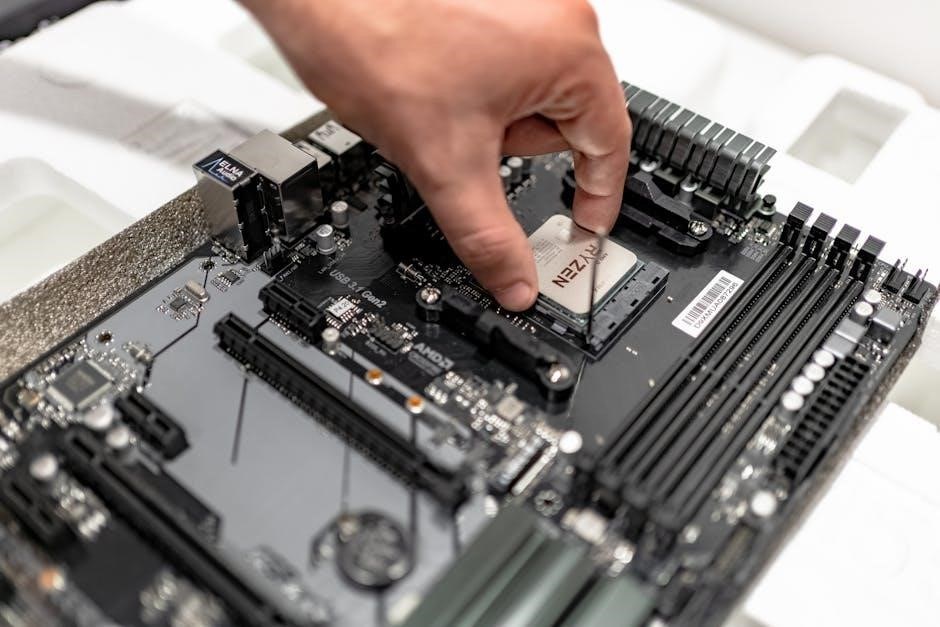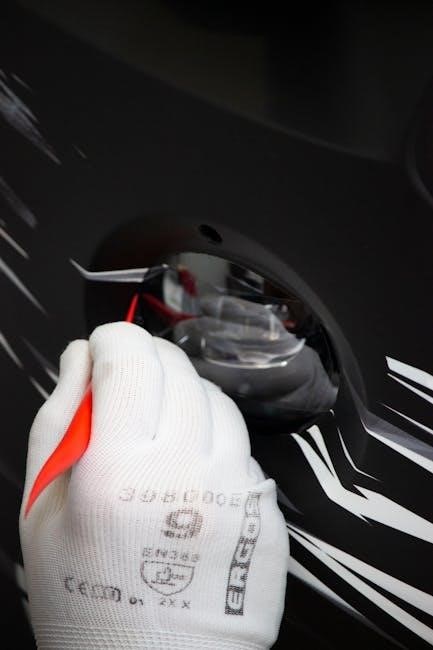Emerson Sensi Installation Manual Article Plan
This comprehensive guide provides a step-by-step walkthrough for installing your Emerson Sensi thermostat. We’ll cover everything from downloading the necessary app to troubleshooting common issues. Sensi thermostats are designed for easy DIY installation, with the Sensi app providing detailed instructions. Let’s get started on setting up your smart thermostat!
Downloading the Sensi App
The first and crucial step in installing your Sensi thermostat is downloading the Sensi app. This app serves as your primary tool for installation, configuration, and control of your new smart thermostat. The Sensi app is available as a free download on both iOS and Android devices, ensuring compatibility with most smartphones and tablets.
To begin, navigate to the App Store (for iOS devices) or the Google Play Store (for Android devices). In the search bar, type “Sensi thermostat” and locate the official Sensi app, developed by Emerson Climate Technologies. Verify that you’ve selected the correct app before proceeding with the download.
Once you’ve located the app, tap the “Install” button to begin the download process. Ensure you have a stable Wi-Fi connection to avoid any interruptions during the download. The download time may vary depending on your internet speed and device performance. After installation, locate the Sensi app icon on your device’s home screen and tap it to launch the app.
The Sensi app is essential to connect your thermostat to your home Wi-Fi network and guide you through the complete installation process. Without the app, configuring and utilizing your Sensi thermostat effectively will be impossible. So, make sure to download and install the app before proceeding with any physical installation steps.
Creating a Sensi Account
After successfully downloading and launching the Sensi app, the next essential step is creating a Sensi account. This account will allow you to register your thermostat, connect it to your Wi-Fi network, and control it remotely from your smartphone or tablet. Creating an account is a straightforward process that only takes a few minutes.
Upon opening the Sensi app for the first time, you’ll be prompted to either log in with an existing account or create a new one. Since you’re installing a new thermostat, select the option to “Create Account” or a similar prompt. You’ll then be guided through a registration form where you’ll need to provide some basic information.
Typically, this includes your full name, email address, and a secure password. It’s crucial to use a valid email address, as you’ll likely need to verify it to activate your account. Choose a strong password that is difficult to guess to protect your thermostat and personal information from unauthorized access.
After filling out the registration form, carefully review the provided information and tap the “Submit” or “Create Account” button. The Sensi app will then send a verification email to the email address you provided. Open your email inbox and locate the verification email from Sensi. Click on the verification link within the email to confirm your email address and activate your Sensi account. Once verified, you can return to the Sensi app and log in with your newly created credentials.
Identifying Your Sensi Thermostat Model
Before commencing the installation process, accurately identifying your specific Sensi thermostat model is paramount. This ensures you select the correct installation instructions within the Sensi app and access model-specific wiring diagrams. Each Sensi thermostat model may have slight variations in wiring configurations, making accurate identification essential for a successful installation.
The model number is typically located on the back of the thermostat’s faceplate. Gently detach the faceplate from the base mounted on the wall. Look for a sticker or label containing the model number, usually indicated by “Model No.,” “Model,” or a similar designation. Common Sensi thermostat model numbers include 1F95U-42WF, ST75, ST55, and others. Make a note of the complete model number, as you’ll need it during the app setup.

If you’re having trouble locating the model number on the faceplate, consult the original packaging or the thermostat’s documentation. The model number is usually printed on the box or included in the user manual. Once you’ve identified the model number, compare it to the list of supported models within the Sensi app during the setup process. Selecting the correct model ensures that the app provides accurate wiring diagrams and instructions tailored to your specific thermostat.
Choosing the wrong model may lead to incorrect wiring, potentially damaging your HVAC system or the thermostat itself. Take the time to accurately identify your Sensi thermostat model to ensure a smooth and trouble-free installation.
Tools Required for Installation
Before you begin installing your Sensi thermostat, it’s essential to gather all the necessary tools to ensure a smooth and efficient process. Having the right tools readily available will prevent delays and potential frustration during the installation.
First and foremost, you’ll need a screwdriver. A multi-bit screwdriver with both Phillips head and flathead bits is ideal, as thermostat wiring often uses both types of screws. Ensure the screwdriver is properly sized to avoid stripping the screw heads. A small level is also crucial for ensuring that your thermostat is mounted straight on the wall, providing a professional and aesthetically pleasing finish. Most Sensi thermostats have a built-in level.
A wire stripper is necessary for safely removing the insulation from the thermostat wires without damaging the copper conductor. A pair of needle-nose pliers can be helpful for bending or straightening wires, especially in tight spaces. You may also need a pencil for marking the wall where you intend to mount the thermostat.
For safety, it’s essential to have a non-contact voltage tester to verify that the power to your HVAC system is turned off before working with the wiring. Additionally, consider having a small flashlight or headlamp to illuminate the wiring area, particularly if it’s dimly lit. Finally, have some wire labels on hand to mark the wires as you disconnect them from your old thermostat. This will greatly simplify the wiring process with your new Sensi thermostat.
Wiring Instructions Using the Sensi App

The Sensi app is your primary guide for wiring your new Sensi thermostat. It provides step-by-step instructions tailored to your specific HVAC system, making the wiring process straightforward and minimizing the risk of errors. Before you begin, ensure you have downloaded the Sensi app and created an account.
The app will first ask you to identify your existing thermostat wiring configuration. It will guide you through taking a picture of your current wiring setup. The app will then provide a wiring diagram that matches your system, showing you exactly which wires to connect to which terminals on the Sensi thermostat baseplate.
Before disconnecting any wires from your old thermostat, use the Sensi app to take a photo of your existing wiring. This photo will serve as a reference point should you need to double-check your connections later. As you disconnect each wire from the old thermostat, use the included wire labels to mark each wire with its corresponding terminal designation (e.g., R, W, Y, G). This is a crucial step to prevent confusion during the rewiring process.
Follow the wiring diagram provided in the Sensi app to connect each labeled wire to the appropriate terminal on the Sensi thermostat baseplate. Ensure that the wires are securely inserted into the terminals and that no bare wire is exposed. Once all the wires are connected, carefully attach the Sensi thermostat to the baseplate. The app will then guide you through the remaining steps of the installation process.
Common Wire (C-Wire) Requirement
A common wire, often called a C-wire, is frequently required for the Sensi thermostat to function correctly, particularly in systems that don’t provide constant power to the thermostat. The C-wire provides a continuous power supply from your HVAC system to the thermostat, which is essential for the thermostat to maintain its Wi-Fi connection and operate its advanced features.
Many older homes may not have a C-wire readily available. If your existing thermostat wiring doesn’t include a wire connected to the “C” terminal, you’ll need to address this before installing your Sensi thermostat. The Sensi app will guide you through identifying whether you have a C-wire or not.
If you lack a C-wire, there are a couple of options. One option is to install a new thermostat cable with an additional wire that can be used as the C-wire. Another option is to use a C-wire adapter, which allows you to repurpose an existing unused wire (typically the G wire, used for the fan) as the C-wire. Emerson offers a Common Wire Kit that simplifies this process.
The Sensi website provides detailed instructions and videos on how to install a C-wire using the Emerson Common Wire Kit. This kit typically involves connecting the adapter to your furnace control board and then connecting the repurposed wire to the C terminal on both the adapter and the Sensi thermostat. Always turn off the power to your HVAC system before working with any wiring.
RC/RH Jumper Information
The RC and RH terminals on a thermostat are related to the power supply for heating and cooling systems. In some systems, a jumper wire connects these two terminals, indicating a single transformer system. Other systems, known as two-transformer systems, have separate power supplies for heating and cooling, and therefore do not require a jumper wire.
The Sensi thermostat is designed to be compatible with both single and two-transformer systems. Fortunately, Sensi thermostats have a built-in RC/RH jumper, eliminating the need for you to manually install a jumper wire in most cases. This simplifies the installation process and reduces the risk of incorrect wiring.
If you have separate wires connected to both the RC and RH terminals on your existing thermostat, it signifies that you have a two-transformer system. In this scenario, you should leave the existing wires connected to the RC and RH terminals on the Sensi thermostat. Do not attempt to install a jumper wire.

However, if your existing thermostat has a jumper wire connecting RC and RH, and only one wire connected to either RC or RH, you should remove the jumper wire before installing the Sensi thermostat. The Sensi’s internal jumper will handle the connection automatically. The Sensi app will guide you through this process, ensuring proper configuration based on your specific wiring setup. Following the app’s instructions is crucial for preventing damage to your HVAC system or the thermostat itself.
Connecting Sensi to Wi-Fi
After the physical installation and wiring of your Sensi thermostat are complete, the next crucial step is connecting it to your home’s Wi-Fi network. This connection enables remote control of your thermostat, energy monitoring, and other smart features. The Sensi app will guide you through this process.
Ensure that your smartphone or tablet is connected to the Wi-Fi network you intend to use for the thermostat. Open the Sensi app and follow the prompts to connect to Wi-Fi. The app will search for your Sensi thermostat and then ask you to select your Wi-Fi network from a list of available networks.
You will need to enter your Wi-Fi password to establish the connection. Double-check the password to ensure it is accurate, as incorrect credentials will prevent the thermostat from connecting. Once the password is entered correctly, the Sensi thermostat will begin the connection process.
The thermostat’s display may show a connecting status or a Wi-Fi symbol. After a successful connection, the Sensi app will confirm that your thermostat is online and ready for use. You can then proceed to configure your HVAC settings and create a schedule to optimize your home’s temperature and energy efficiency. If you encounter any issues during the Wi-Fi connection process, consult the troubleshooting section of the Sensi app or the online support resources for assistance. Having your Wi-Fi network name and password readily available will streamline the connection process.
Configuring HVAC Settings After Installation
Once your Sensi thermostat is successfully installed and connected to Wi-Fi, the next important step is configuring the HVAC settings within the Sensi app. This ensures that the thermostat operates correctly with your specific heating and cooling system. Accurate configuration is crucial for optimal performance and energy efficiency.
The Sensi app will guide you through a series of questions to identify your system type, such as forced air, heat pump, or radiant heat. You’ll also need to specify whether you have a single-stage, multi-stage, or modulating system. Providing accurate information is essential for the thermostat to control your HVAC equipment effectively. The app may also ask about the presence of a dual-fuel system, which combines a heat pump with a gas furnace.
Carefully review each setting to ensure it matches your system’s specifications. Incorrect settings can lead to inefficient operation or even damage to your equipment. If you are unsure about any of the settings, consult your HVAC system’s documentation or contact a qualified technician for assistance. After entering all the necessary information, the Sensi app will save your configuration and begin controlling your HVAC system based on your preferences and schedule. Regularly check these settings to ensure they remain accurate and adjust them as needed to optimize your home’s comfort and energy savings.
Troubleshooting Installation Issues
Even with careful planning, installation of a Sensi thermostat can sometimes present challenges. Common issues range from wiring complications to connectivity problems. Don’t worry; most issues can be resolved with a systematic approach.

First, double-check all wiring connections. Ensure each wire is securely inserted into the correct terminal, matching the labels from your old thermostat and the Sensi app’s instructions. Loose or incorrect wiring is a frequent cause of malfunctions. If your system isn’t turning on, verify that the breaker for your HVAC system is on. Next, confirm your Wi-Fi network is working correctly. The Sensi thermostat requires a stable connection to function optimally. Make sure you’ve entered the correct Wi-Fi password and that your router is within range.
If you’re still experiencing problems, consult the Sensi app’s troubleshooting section, which offers solutions for many common issues. You can also visit the Emerson Sensi support website for FAQs and detailed guides. Another helpful resource is the Sensi community forum, where users share their experiences and solutions. If all else fails, contacting Sensi customer support is a good idea. They can provide personalized assistance to help you diagnose and resolve the issue, ensuring your Sensi thermostat operates as expected.
Finding Professional Installation Help
While the Sensi thermostat is designed for straightforward DIY installation, there are situations where professional help is necessary. If you’re uncomfortable working with electrical wiring or if you encounter complex HVAC configurations, it’s best to seek assistance from a qualified technician.
One of the easiest ways to find a reliable installer is through the Sensi Partner program. Emerson maintains a network of certified professionals who are experienced in installing Sensi thermostats. You can locate a Sensi Partner in your area using the “Find-a-Pro” tool on the Sensi website. These professionals have the expertise to handle any installation challenge, ensuring your thermostat is set up correctly and safely.
Alternatively, you can search for local HVAC contractors through online directories or by asking for recommendations from friends and family. When choosing a professional, make sure they are licensed, insured, and have positive reviews. It’s also a good idea to get quotes from multiple contractors to compare prices and services. A professional installation not only guarantees proper setup but can also prevent potential issues down the line, saving you time and money in the long run. They can also answer any questions about your system!
